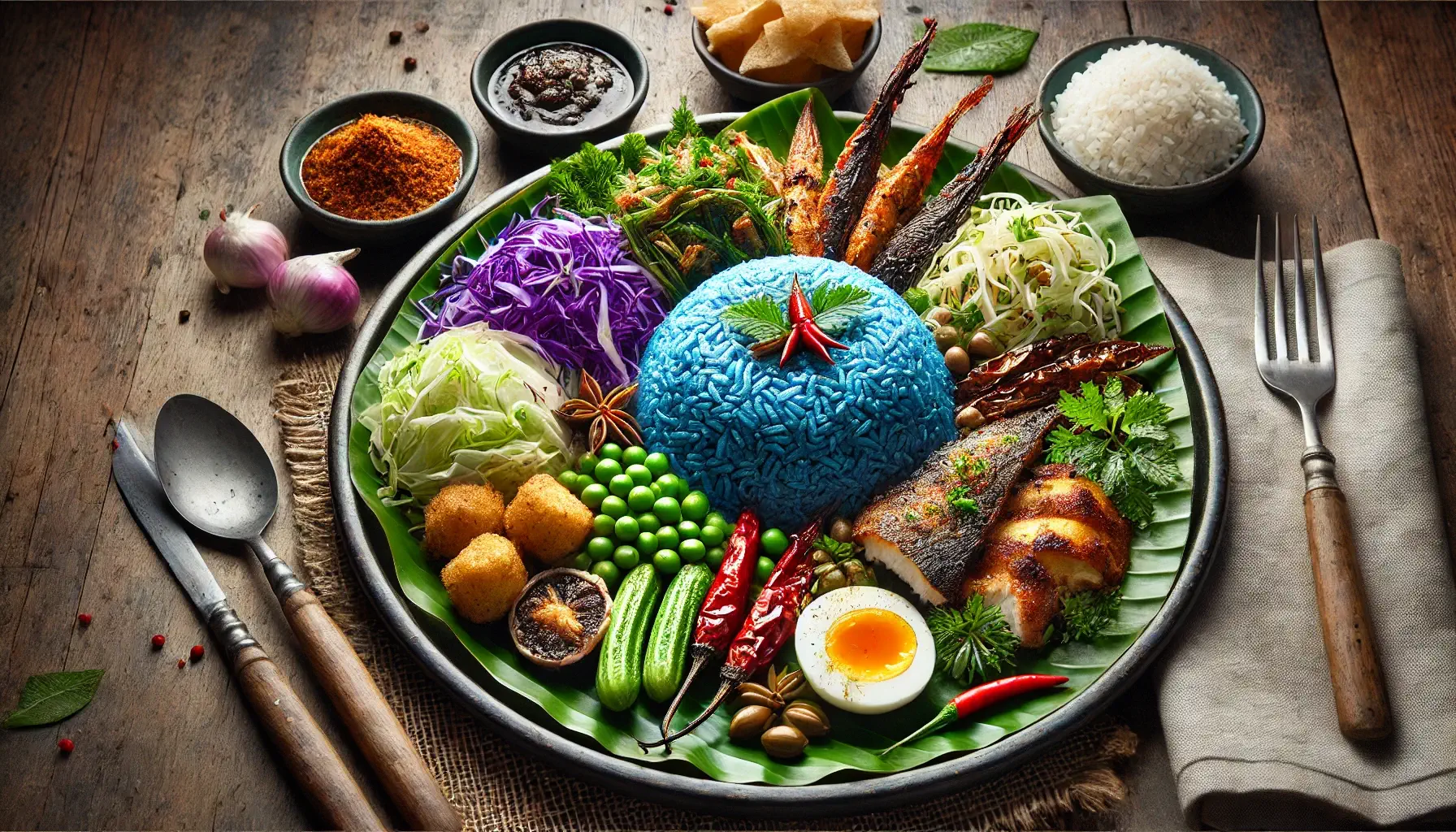Nasi Kerabu

Nasi Kerabu is a traditional Malaysian dish that hails from the northeastern states, particularly Kelantan. It is a visually striking meal, distinguished by its vibrant blue rice, which gets its color from butterfly pea flowers (Clitoria ternatea). This dish is not only a feast for the eyes but also a delightful combination of flavors and textures that reflect the rich culinary heritage of Malaysia.
Nasi kerabu is a Malaysian rice dish, a type of nasi ulam, in which blue-colored rice is eaten with dried fish or fried chicken, crackers, pickles and other
Origin and Regional Cuisine: Nasi Kerabu is a traditional dish from the northeastern coast of West Malaysia, specifically in the states of Kelantan and Terengganu. It has since gained popularity throughout the country and even in neighboring Singapore. It is a variant of nasi ulam, a broader category of Malay herb rice salads.
Category
Main dish/rice dish. It is a form of nasi ulam, a rice salad, and is often served for breakfast or lunch.
Appearance
The most striking feature of Nasi Kerabu is its vibrant, electric blue rice. This color is achieved naturally by cooking the rice with the petals of the butterfly pea flower (Clitoria ternatea). The blue rice is served with a colorful and generous spread of finely sliced raw or blanched herbs and vegetables, creating a visually stunning and dynamic plate.
Ingredients
The Nasi Kerabu dish is composed of several key components:
- Blue Rice: Rice cooked with butterfly pea flowers, and often pandan leaf and lemongrass for fragrance.
- Herbs and Vegetables (Ulam): A finely sliced mixture of raw herbs and vegetables, which can include long beans, bean sprouts, cabbage, daun kesum (Vietnamese coriander), Thai basil, and torch ginger bud.
- Fish Floss (Serunding Ikan): A dry, shredded fish (often mackerel) mixed with toasted grated coconut (kerisik), shallots, and ginger.
- Spicy Condiments:
- Sambal Tumis Kelapa: A coconut sauce.
- Sambal Budu: A dipping sauce made from fermented fish.
- Accompaniments: These can vary but commonly include:
- Grilled or fried fish (such as mackerel or pomfret) or fried chicken.
- Salted egg (telur masin).
- Fish or prawn crackers (keropok).
- Pickled vegetables.
- Stuffed chilies (solok lada).
Preparation
Preparing Nasi Kerabu is a multi-step process due to its various components:
- Blue Rice: Rice is washed and cooked with water that has been infused with butterfly pea flowers. A stalk of bruised lemongrass and pandan leaf are often added to the rice cooker for aroma.
- Herb Salad (Ulam): The herbs and vegetables are meticulously washed and finely sliced or shredded.
- Fish Floss (Serunding Ikan): The fish is boiled or grilled, deboned, and then pounded or blended with toasted coconut and other spices until it forms a dry, fluffy floss.
- Accompaniments: The side dishes, such as grilled fish, fried chicken, or solok lada, are prepared separately.
- Assembly: The cooked blue rice is placed on a plate and topped with the various components, allowing the diner to mix them all together before eating.
Equipment
Standard kitchen equipment is used, including a rice cooker, pots/pans, a sharp knife for slicing the herbs, and a food processor or a traditional pestle and mortar for making the fish floss and sauces.
Variations: While the classic nasi kerabu is known for its blue rice, there are other variations. The rice can also be white, yellow (from turmeric), or even grey (from noni leaves). The choice of protein can also vary widely, from grilled beef to fried chicken.
Taste
Nasi Kerabu offers a complex and balanced flavor profile. The taste is a rich blend of:
- Earthy and Herbal: From the ulam (herb salad).
- Salty and Savory: From the salted egg, fish floss, and fish crackers.
- Spicy: From the sambal.
- Slightly Sweet and Nutty: From the toasted coconut.
- Tangy: From the lime and pickled vegetables.
- Subtle and Floral: A very mild, almost undetectable floral note from the butterfly pea flowers in the rice.
Texture
The dish is an exciting mix of textures, providing a satisfying contrast:
- Fluffy: The steamed rice.
- Crispy: The fish/prawn crackers and fried protein.
- Crunchy: The raw, sliced vegetables and herbs.
- Chewy: The toasted coconut and fish floss.
- Soft: The salted egg.
Aroma
Nasi Kerabu is highly aromatic. The scent is a combination of:
- Fragrant: From the pandan and lemongrass in the rice.
- Earthy and Pungent: From the various raw herbs.
- Nutty: From the toasted coconut.
- Smoky: From the grilled protein.
- Spicy: From the chili sambal.
Cultural Significance
Nasi Kerabu is a staple of Kelantanese culture and is a source of regional pride. It reflects the local community’s close relationship with the land and the use of indigenous ingredients. It is a traditional meal often enjoyed as a daily diet, for special occasions, and as an iftar (break fast) meal during Ramadan. The practice of eating it with one’s hands is also a nod to traditional Malay dining customs.
Symbolism
The vibrant blue rice, with its accompanying red, white, and other colorful components, has been used as a metaphor for the diversity and complex, yet harmonious, relationship of different cultures.
Social Context
Nasi Kerabu is a meal that is often shared and is a popular street food, sold at markets and food stalls. Its preparation can be a communal effort, especially for large gatherings.
Nutritional Information and Health Benefits
Nasi Kerabu is considered a relatively healthy and nutritious dish.
- The abundance of raw herbs and vegetables provides a high amount of fiber and essential vitamins.
- The use of grilled or fried protein and fish floss provides a good source of protein.
- The fresh ingredients and lack of heavy oils (in some preparations) make it a balanced meal.
Dietary Restrictions and Allergens
- Gluten-Free: The base of rice and most of the core ingredients are naturally gluten-free. However, it’s important to confirm that any sauces or marinades used for the protein (e.g., soy sauce) do not contain gluten.
- Allergens: Common allergens include:
- Shellfish: Prawn crackers, shrimp paste (belacan) in some sambal.
- Fish: The fish floss (serunding ikan) and fish crackers.
- Peanuts: Some variations might include peanuts as a garnish.
Cost and Availability
Nasi Kerabu is widely available in Kelantan and Terengganu, and increasingly in other parts of Malaysia. It is an affordable and accessible meal, with prices for a single serving typically ranging from RM5 to RM10.
The Key Components of Nasi Kerabu
The beauty of Nasi Kerabu lies in its diverse components, each playing a significant role in delivering its unique taste. Here are the essential elements:
- Blue Rice (Nasi Biru): The rice is traditionally cooked with butterfly pea flowers, giving it a stunning blue hue. The flowers not only add color but also provide a subtle, earthy aroma.
- Ulam (Fresh Herbs and Vegetables): A variety of finely sliced fresh herbs and vegetables such as torch ginger (bunga kantan), long beans, cabbage, and Vietnamese coriander (kesum) are added to enhance the freshness and crunch.
- Protein Options: Nasi Kerabu is commonly served with grilled or fried protein choices, such as:
- Ayam Percik (grilled spiced chicken with coconut sauce)
- Daging Bakar (grilled beef)
- Ikan Goreng (fried fish)
- Solok Lada (stuffed chili with fish paste)
- Kerisik (Toasted Grated Coconut): Toasted coconut flakes are mixed with spices to provide a rich, nutty flavor that complements the other ingredients.
- Budu (Fermented Anchovy Sauce): A staple condiment in Kelantanese cuisine, budu is a fermented fish sauce that adds depth and umami to the dish. It is often mixed with lime juice, chili, and shallots for extra flavor.
- Eggs and Crackers: A serving of Nasi Kerabu is often accompanied by salted eggs or hard-boiled eggs. Additionally, crispy fish crackers (keropok) add a delightful crunch.
Cultural Significance and Popularity
Nasi Kerabu is more than just a meal—it is a symbol of Malaysia’s diverse culinary landscape. The dish is deeply rooted in Kelantanese culture and has gained popularity across the country and even internationally. It is often enjoyed for breakfast, lunch, or dinner, and is a staple at Malaysian food markets and traditional eateries.
How to Prepare Nasi Kerabu
Servings
5 minutes
Preparing Time
60 minutes
Cooking Time
30 minutes
Calories
kcal
INGREDIENTS
500 gm Basmati Rice
1 piece of Lemongrass
1 tsp Salt
1 large Banana leaf
1 large Tamarind
15 pieces Dry red chilies
2 tbsp Soy sauce
2 tbsp Roasted peanuts
1 piece Onion
6 pieces Sambar onions
2 tbsp Cold pressed sesame oil
1 tsp Turmeric powder
1 cup Coconut milk
1 large Coconut
2 pieces Mangoes
1 piece Cabbage
DIRECTION
- Nasi Kerabu Cooking
Toast the rice for 5 minutes. Add the pandan leaves, lemongrass leaves, the drained water obtained after boiling the cabbage and if needed, some extra water. Cook the rice well.
NOTES
How to Prepare Nasi Kerabu: A Traditional Malaysian Rice Delicacy. Nasi Kerabu is a colorful traditional dish from Malaysia, famous for its blue-colored rice and an array of vibrant accompaniments. Often served with herbs, fried fish or chicken, crackers, and a tangy sambal, this dish is a unique culinary experience that combines various textures and flavors.
Cooking Steps
- Step 1: Pickling the Vegetables
Thinly slice the carrots and cucumbers.
In a pot, mix vinegar, half a cup of water, sugar, and 1 teaspoon of salt. Bring this mixture to a boil.
Place the vegetable slices in a jar and pour the hot mixture over them. Seal the jar and refrigerate. These pickled vegetables can last a few weeks. - Step 2: Preparing the Paste
Blend all ingredients together in a blender, adding water as needed. Save 1-2 teaspoons of the paste for marinating tofu/tempeh later.
- Step 3: Cooking the Sauce
Heat cold-pressed sesame oil in a pan. Add the blended paste and sauté until fragrant.
Lower the heat and add coconut milk, allowing the mixture to simmer until the sauce thickens. - Step 4: Marinating and Frying Tofu/Tempeh
Marinate cubed tofu/tempeh with the reserved paste and a pinch of chili powder and salt. Let it rest for at least 30 minutes.
Heat cold-pressed sunflower oil and deep-fry the marinated tofu/tempeh until crispy. - Step 5: Preparing the Rice
In a pressure cooker, heat a tablespoon of sunflower oil and toast the rice for 5 minutes.
Add lemongrass, pandan leaves, and the drained water from boiled cabbage. Cook the rice until fluffy. - Step 6: Preparing the Garnishes
Boil shredded cabbage for 5 minutes, drain, and sauté with chili powder and salt.
Toast peanuts and coconut separately until browned, seasoning with chili flakes, salt, and a pinch of sugar.
Grate raw mango and mix with sugar/jaggery and turmeric. - Step 7: Plating
Spread a banana leaf on a plate, place the rice in the center.
Arrange the garnishes—pickled vegetables, fried tofu, coconut mix, peanuts, and sautéed cabbage—around the rice in a colorful pattern.
Drizzle the sauce on top and garnish with chopped lemongrass.
In Kelantan, nasi kerabu is often eaten with solok lada, which are fish paste-stuffed chilies simmered in coconut milk.
Nasi Kerabu is a flavorful heritage of Malaysian cuisine. With its unique blue rice, aromatic herbs, and a combination of sweet, salty, and spicy flavors, this dish offers an unforgettable culinary experience. Whether you are a food enthusiast or a traveler looking to explore Malaysian flavors, Nasi Kerabu is a must-try dish that showcases the best of Malaysia’s gastronomic diversity.
FAQ
A typical nasi kerabu recipe usually calls for blue-coloured rice (coloured with blue flower extract), fish, chicken, salted egg, vegetables, fish crackers and most importantly — the budu condiment made of fish sauce and fish flakes on top.
The blue color of the rice comes from the petals of Clitoria ternatea (butterfly-pea) flowers (bunga telang), which are used as a natural food coloring in cooking it. The rice can also be plain white rice or rice cooked using turmeric.
Rich in fiber and nutrients, nasi kerabu can appeal to health-conscious diners. “My doctor recommends nasi kerabu for its balanced nutrients, including noni-infused rice, protein-rich roasted fish and vitamin-packed herbs.
Nasi Kerabu is a unique Malay rice dish with the rice in blue colour, a type of nasi ulam. It is quite popular as a breakfast dish for Kelantanese. It is eaten with various mixture of Ulam (traditional local salad), crackers, fish or fried chicken, pickles, hard-boiled salted egg.













Comments are closed.